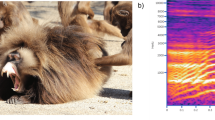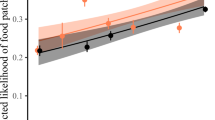Abstract
We have observed wild western lowland gorillas (Gorilla gorilla gorilla) using water to generate spectacular 'splash displays'. Most of these displays were made by silverbacks in an agonistic context, and we propose that they are primarily linked to the intimidation of potential rivals for female acquisition. This unusual behaviour may have developed only in gorillas that visit open swampland, where visibility greatly exceeds that encountered in the forest and highly visual, long-distance displays are therefore of value.
Similar content being viewed by others
Main
Almost nothing is known about the social behaviour of western lowland gorillas because of poor observation conditions and difficulties of habituation in dense forest. But the discovery that large numbers of gorillas feed in open, swampy clearings (bais) in the forest of northern Congo means that their social interaction can be investigated.
Display behaviour incorporating objects in the environment occurs in agonistic encounters in all ape species1, but manipulating water for communication has not been described in any wild primate and, with the possible exception of elephants, may be unique among terrestrial mammals.
We observed 124 gorillas over 32 months at the 12.9-hectare 'Mbeli Bai'. Gorillas were visible for 27% (1,681 h) of the time that we were present at the clearing. Ninety splash displays, representing 57 independent bouts of social interaction, were produced by 19 individuals (4 unaffiliated, 'solitary' silverback males and 15 individuals from 9 groups). Ten display styles were seen, of which three were used in 75% of all displays. These were the 'body splash' (35% of displays), in which a gorilla runs or leaps into standing water of up to 1.5 m in depth (Fig. 1), and one-handed and two-handed splashes (40%), in which one or both arms are raised and then brought down forcibly, the open palms striking the water surface at a slight angle. Each of these three techniques generates large plumes of spray.
Of all splash-display bouts, 67% were produced in an agonistic context, 17.5% were made in play and 5% were directed towards other species; in 10.5% of cases the context was not evident. Silverbacks displayed the most frequently (68%), and almost exclusively in an agonistic context.
When the observed frequencies of splash bouts were compared with the expected frequencies (calculated from the proportion of visits made to the bai by each age/sex class), group silverbacks displayed twice as often as expected, whereas solitary silverbacks displayed more than four times as often. Solitary silverbacks were also the most frequent recipients of the display (six times more often than expected). Adult females, although they were the most frequently seen age/sex class, never produced splash displays and were rarely targeted.
Directly attracting the attention of females is not considered the prime purpose of splash displays, because solitary males displayed almost as frequently to other solitary males as to groups, and in more than half of these cases no females were in sight. The more likely purpose is to intimidate potential competitors for acquiring females.
Splash displays are an example of object-mediated behavioural plasticity in response to unusual circumstances. Although the three primary display styles resemble the dry-land charges and ground-slap displays seen in many gorilla populations, differences in context, execution and intra-dyad distance confirm that splash displays represent a distinct behavioural element in gorillas' visual-display repertoire.
The bai offers visibility of up to 500 m, which is never encountered by gorillas in the forest, and so long-distance visual displays are clearly expedient. In the wild, the only other record of splash display comes from western lowland gorillas at Maya Bai, 180 km from Mbeli (F. Magliocca, personal communication).
The paucity of data on western lowland gorillas has led to generalizations about their behaviour based on that of mountain gorillas (G. beringei beringei). But their feeding ecology is different2, and our findings indicate that their social behaviour is too. We anticipate that gorillas, maligned as cognitively poor cousins to the other great apes, will emerge from further bai studies as adaptable, innovative and intelligent creatures that exploit a complex environment3.
References
Beck, B. B. Animal Tool Behavior: The Use and Manufacture of Tools by Animals (Garland, New York, 1980).
Williamson, E. A. et al.M. Am. J. Primatol. 21, 265–277 (1990).
Byrne, R. W. in Reaching into Thought: The Minds of the Great Apes (eds Russon, A. E., Bard, K. A. & Taylor Parker, S.) 111–130 (Cambridge Univ. Press, Cambridge, 1996).
Author information
Authors and Affiliations
Corresponding author
Rights and permissions
About this article
Cite this article
Parnell, R., Buchanan-Smith, H. An unusual social display by gorillas. Nature 412, 294 (2001). https://doi.org/10.1038/35085631
Issue Date:
DOI: https://doi.org/10.1038/35085631
Comments
By submitting a comment you agree to abide by our Terms and Community Guidelines. If you find something abusive or that does not comply with our terms or guidelines please flag it as inappropriate.




